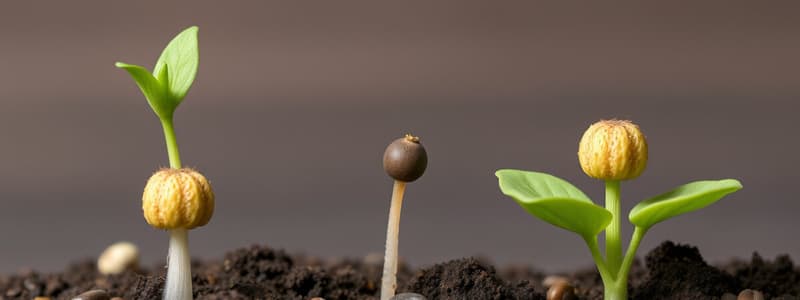Podcast
Questions and Answers
What is the primary role of the embryo in plant development?
What is the primary role of the embryo in plant development?
Which type of seed has no endosperm at maturity?
Which type of seed has no endosperm at maturity?
Which layer of the seed coat is known as the Testa?
Which layer of the seed coat is known as the Testa?
What is the function of the appendages on some seeds?
What is the function of the appendages on some seeds?
Signup and view all the answers
Which of the following is considered a non-endospermic dicot?
Which of the following is considered a non-endospermic dicot?
Signup and view all the answers
What type of germination ensures that cotyledons remain below or on the surface of the ground?
What type of germination ensures that cotyledons remain below or on the surface of the ground?
Signup and view all the answers
Which seed coat type contains two integuments?
Which seed coat type contains two integuments?
Signup and view all the answers
Which crop's seeds are characterized by the presence of an aril?
Which crop's seeds are characterized by the presence of an aril?
Signup and view all the answers
What is the main stored food material in cereal seeds?
What is the main stored food material in cereal seeds?
Signup and view all the answers
Which of the following is an example of a monocot?
Which of the following is an example of a monocot?
Signup and view all the answers
What type of seed is found in all legumes?
What type of seed is found in all legumes?
Signup and view all the answers
Which germination type is exemplified by most monocots?
Which germination type is exemplified by most monocots?
Signup and view all the answers
Which method of pollen grain dissemination involves snails?
Which method of pollen grain dissemination involves snails?
Signup and view all the answers
Which of the following is NOT a feature of double fertilization in angiosperms?
Which of the following is NOT a feature of double fertilization in angiosperms?
Signup and view all the answers
What type of seed behavior is classified as 'Orthodox'?
What type of seed behavior is classified as 'Orthodox'?
Signup and view all the answers
Which example is a type of epigeal germination?
Which example is a type of epigeal germination?
Signup and view all the answers
Which agent is associated with hydrophily?
Which agent is associated with hydrophily?
Signup and view all the answers
What is the total number of cells present in an embryo sac?
What is the total number of cells present in an embryo sac?
Signup and view all the answers
Which of the following is a characteristic of recalcitrant seeds?
Which of the following is a characteristic of recalcitrant seeds?
Signup and view all the answers
Which type of pollination occurs when pollen is transferred to another flower?
Which type of pollination occurs when pollen is transferred to another flower?
Signup and view all the answers
Study Notes
Classification of Seeds
- Seeds can be classified based on usage into cereals, oilseeds, pulses, fiber, green manure, vegetables, medicinal, and sylvicultural species.
- Two main categories based on cotyledons: monocots (one cotyledon) and dicots (two cotyledons).
- Seeds with endosperm are termed endospermic (e.g., all cereals, castor, fenugreek), while those without are non-endospermic (e.g., all legumes).
- Germination types include hypogeal (cotyledons remain below ground) and epigeal (cotyledons emerge above ground).
Germination Types
- Hypogeal Germination: Common in monocots and some dicots like gram, pea, and maize.
- Epigeal Germination: Found in species such as bean, cotton, and sunflower.
- Hypo-epigeal Germination: Example includes Peperomia peruviana.
Storage Behaviour
- Orthodox Seeds: Includes most food crops, beans, fruits like peach and guava, able to withstand drying and low temperatures.
- Recalcitrant Seeds: Found in forest and horticultural crops like avocado, cacao, mango, and rubber; sensitive to drying.
Pollination
- Pollen release occurs from mature anthers, leading to self-pollination (autogamy) or cross-pollination (allogamy).
- Various agents facilitate pollen dissemination:
- Wind (anemophily)
- Water (hydrophily)
- Insects (entomophily)
- Birds (ornithophily)
- Snails (malacophily)
- Wasps (waspophily)
- Flies (myophily)
- Bats (chiropterophily)
Fertilization
- Involves fusion of male and female gametes to form an embryo.
- Embryo sac consists of 7 cells and 8 nuclei, with distinct structures including egg apparatus (1 egg cell and 2 synergids) and polar nuclei (2 in center).
- Angiosperms undergo double fertilization, utilizing 2 male nuclei.
Seed Structure and Development
-
Embryo: Immature plant with one cotyledon in monocots and typically two in dicots.
-
Monocot Examples: Wheat, rice, banana, palm.
-
Dicot Examples: Legumes, daisies, tomatoes, and oak trees.
-
Endosperm:
- Albuminous Seeds: Endosperm persists at maturity; common in most monocots (e.g., cereals).
- Exalbuminous Seeds: Endosperm consumed during development; found in most legumes.
-
Seed Coat:
- Composed of two layers: outer layer (testa) and inner layer (tegmen).
- Provides mechanical protection to the embryo.
- Unitegmic: Single integument in ovule.
- Bitegmic: Two integuments, with variations in seed coat development.
Appendages of Seed
- Different crops exhibit various seed coat appendages aiding in dispersal or identification:
- Awn (paddy)
- Hilum (pulses)
- Caruncle (castor, tapioca)
- Aril (nutmeg)
- Hairs (cotton)
- Wings (moringa)
Germination Classification
- Hypogeal Germination: Maintains cotyledons below ground surface during growth, typical of many monocots and certain dicots.
Studying That Suits You
Use AI to generate personalized quizzes and flashcards to suit your learning preferences.
Description
Explore the fascinating world of seeds with this quiz covering their classification based on usage and cotyledon types. Understand the mechanisms of germination and the storage behaviors of orthodox and recalcitrant seeds. Test your knowledge on different types of germination and their examples.




